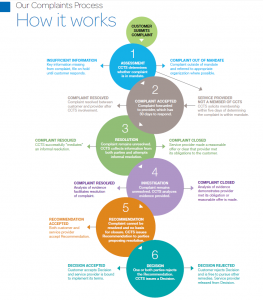
The Commissioner for Complaints for Telecommunications Services (“CCTS“) released its 2011-2012 Annual Report this morning.
In January 2011, the CRTC expanded the mandate of the CCTS, requiring that all Canadian telecommunications service providers must participate in the CCTS process, no later than 5 days after the CCTS notifies a service provider that a complaint has been received from one of their customers.
In the past year, 38 new service providers have signed up; there are now 178 service providers and brands that are participating in the CCTS dispute resolution process. In the past year, more than 10,000 complaints were accepted by CCTS, an increase of 35% over the 8,000 accepted the previous year.
This growth is likely due to increased awareness of the CCTS as an arbitrator of last resort.
From an operational perspective, the CCTS reports that 90% of the complaints (9,626 of 10, 838) were resolved by the investigation stage, with a further thousand complaints closed by that stage, meaning that 98.5% of the complaints were concluded prior to a recommendation being required.
Just over 70% of the formal recommendations made were accepted by both the service provider and the customer.
The complaints process is described on the CCTS website.
Billing and contract issues seem to head the list of complaints. Nearly one in ten complaints dealt with early termination fees.
Fewer that 7% of the complaints dealt with service quality.
About 60% of complaints were wireless services related.
The report observed:
For example, many billing complaints arose simply because incorrect information about prices was provided to the customer, in particular when obtaining service over the phone. Others were attributable to invoices not being clear. Many billing complaints were the result of the sheer complexity of the monthly plan, in particular for wireless services and the various features, inclusions and exclusions associated with the plans. Other complaints seemed to be the result of a lack of training of customer service representatives (CSRs) about the products and services offered by the provider. In some cases, we wonder whether complaints arise because CSRs are required to meet certain sales targets or have sales incentives that increase their compensation. And of course, some billing errors occurred simply as a result of human or data entry errors. In our experience, service providers could help reduce the number of complaints about billing issues, and avoid much of the frustration experienced by their customers, by proactively addressing these matters.
Given the large number of complaints about billing issues, and the fact that many of these complaints could have been avoided, we strongly urge service providers to review their billing practices and take steps to ensure that they produce comprehensible and accurate invoices. We also recommend that appropriate training and supervision be provided to CSRs to guarantee that accurate information about products and services is provided to customers at all times, and to confirm that the customer understands and consents before service is provided.
The CCTS asks some questions that should cause industry executives to shake their heads.
- If the solutions in so many cases were so “obvious” and the resolutions so “simple”, why were these customers required to bring their complaints to CCTS?
- Why were the service providers’ internal complaint-handling processes unable to resolve these complaints directly with the customer at the outset?
- Many service providers have multiple levels in their internal complaint-handling processes. How did these complaints get through so many levels?
- How much extra time and effort was the customer forced to go through because of the service provider’s inability or unwillingness to correct obvious errors?
Six years ago, I said that executives at companies should deal with the normal customer service processes for their perquisite devices and services.
Given the choice, as an alternative to calling a carrier for customer support, I would rather undergo root canal treatment performed by a carpenter with a rusty icepick. Insert the name of whatever carrier you want. It dosn’t seem to matter which one of my service providers I happen to call.
I’ll say it again: If carriers aren’t having their employees and executives treated like a normal customer, you should change the way you handle internal accounts immediately. You need to see what you are doing to your customers. Monthly bills that are tough to read; interactive voice response units that can’t be navigated.
Some perspective is warranted. There are roughly 28M mobile lines in Canada, 10M internet access lines and 12M residential phone lines. That means 50M access services have generated these 10,000 complaints – a rate of about one per year out of 5,000 services. Not too bad, unless you are one of the victims on the receiving end.
Read the case studies in the CCTS Annual Report. Some of them will make you shake your head in wonder.
Check out the statistics at the back of the report to see which carriers have improved and which have the most work to do. Will customer care executives be watching their numbers?



 I still remember when most of the world had phone service provided by the government post office and telegraph department. It was a very sorry state of affairs. Service was predictably awful; in some countries, new installations could take years.
I still remember when most of the world had phone service provided by the government post office and telegraph department. It was a very sorry state of affairs. Service was predictably awful; in some countries, new installations could take years.